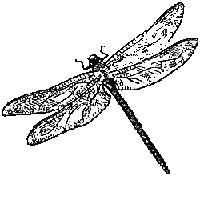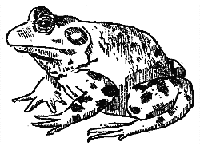Activity 24: Where's Wetland?
This online activity has been adapted from the
Wildlife in Jeopardy Education Kit and
accompanies Theme 7: Wetlands.
Abstract
Many species at risk around the world occur in wetland habitats.
There are over 50 significant wetlands in Ontario south and east of the Canadian Shield.
During this activity you will locate a wetland in your area then check out the plants
and wildlife in this unique type of habitat.
For families and Science, grades 4, 6, 7, 10 Academic, 10 Applied and Geography,
grades 9 Academic and 9 Applied as well as Guides Conservation Badge and Scouts
Conservation (Water) Badge.
 |
|
dragonfly
|
The FON has identified 53 wetlands in southern Ontario that are particularly significant
(see map below).
Have students pinpoint the approximate location of their school on the wetland map
and then identify any nearby wetlands.
As an outdoor component of this activity, arrange a field trip to one of these wetlands.
If possible, try to go in late May or June when many wetland species will be active.
Have students try to identify some wetland species using a field guide.
Treading carefully, can students find and identify any of the following?
-
Late May/early June marks the
emergence of damselflies and dragonflies in wetlands.
They are not only beautiful, they are also the natural predators of a variety of insects,
including mosquitoes.
-
Predators of insects can include plants!
Look for the pitcher plant or sundew blooming in June/July in bogs and fens (some of them can stand two feet [0.66 metres] tall!).
-
Look for turtles sunning themselves on exposed logs or rocks in ponds and marshes. Creep quietly though. Even though their hard shell protects them, they are very wary of intrusion and will often dive before you get a good look.
-
Can you hear loud splashing? Do students see water being thrashed? This may indicate fish are spawning in the warm shallows of marshes,
protected lakes, and bays.
 |
|
bullfrog
|
-
Canada's largest frog, the bullfrog, breeds in June and July in marshes, lakes, and deep ponds. Have students look carefully for floating masses of jelly. Those may be the 12,000 to 22,000 eggs of the bullfrog. Look also for green, leopard and wood frogs.
-
Are there arrow-shaped leaves and white flowers on some wetland plants?
These are arrowhead plants, the tuberous roots
of which are called "wild potato."
-
Are there any noticeable signs of wetland destruction such as pollution, garbage, housing developments, or evidence of acid precipitation? What can you, your class, and your community do to help preserve the remaining wetland habitat?
| Curriculum Links |
Grade 4
Science and Technology - Life
Systems:
Grade 6
Science and Technology - Life
Systems:
- Diversity of Living Things
Grade 7
Science and Technology - Life Systems:
- Interactions within Ecosystems
Grade 9
Geography, Academic:
Geography, Applied:
- Human-Environment Interactions
Grade 10
Science - Academic Biology:
- The Sustainability of Ecosystems
Science - Applied Biology:
- Ecosystems and Human Activity
For more information on the Ontario Curriculum, please visit
the Ministry Of Education Web site at www.edu.gov.on.ca/eng/general/elemsec/elemsec.html.
|
| Guides and Scouts Badge Requirements |
Scouts Badge/Award
- Naturalist
- Soil and Water Management
Guides Badge
- Conservation
- Endangered Species
|
Significant Wetlands of Ontario
 |
Significant Wetlands of Ontario. Legend:
1 Alfred Bog,
2 Amherst Island Marshes,
3 Backus Woods Swamp,
4 Beaverdale Fen,
5 Beverly Swamp,
6 Big Creek Marsh,
7 Byron Bog,
8 Cavan Swamp and Bog,
9 Chesney Bog,
10 Cootes Paradise Marsh,
11 Corisande Bay ,
12 Dorcas Bay Fen,
13 Dorchester Swamp,
14 Dunnville Marshes,
15 Fifteen Mile Creek Marsh,
16 Greenock Swamp,
17 Hay Bay Marshes,
18 Hillman Marsh,
19 Holland River Marsh,
20 Howdenvale Bay Fen,
21 Jordan Harbour Marshes,
22 Lake St. Clair Marshes,
23 Levay's Marsh,
24 Lighthouse Point Marsh,
25 Long & Turkey Point Marsh,
26 Lower Rouge Marsh,
27 Luther Marsh,
28 Manion Corners Long Swamp Fen,
29 Matchedash Bay Marshes,
30 Mer Bleue Bog,
31 Minesing Swamp,
32 Mud Pond & Shirley's Bay,
33 Murray Marsh,
34 Newington Bog,
35 Oliphant Shoreline,
36 Oshawa Second Marsh,
37 Oxley Poison Sumac Swamp,
38 Point Pelee Marshes,
39 Port Franks Wetlands,
40 Pottageville Swamp,
41 Presqu'ile Park Marsh,
42 Richmond Fen Complex,
43 Rondeau Bay Marshes,
44 Saratoga Swamp,
45 Scugog Marsh,
46 Skunk's Misery Swamp,
47 Spongy Lake Bog,
48 Stoco Fen,
49 Sucker Creek Fen,
50 Wainfleet Bog,
51 Walpole Island Marshes,
52 White Lake Fen,
53 Wye Marsh.
From: Some Important Wetlands of Ontario South of the
Precambrian Shield by Mark Van Potter and Dr. Stewart Hilts.
Federation of Ontario Naturalists, 1985.
|
|
|
|
|